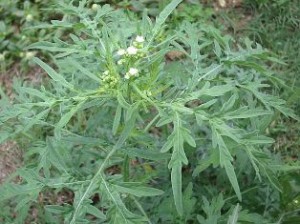 At the national and state level, we’ve all heard that weeds are a major threat to the environment, agriculture and the economy.
At the national and state level, we’ve all heard that weeds are a major threat to the environment, agriculture and the economy.
But just what do weeds mean to us directly and why should we be concerned about them at the local property level?
If you’ve suddenly discovered a serious weed on your property or job site, there’s a lot more to be worried about than just the declared weed classification…
Weeds can rapidly colonise disturbed areas
Let’s take Parthenium hysterophorus for example:
- parthenium is currently recognised in Qld as a declared Class 2, and also a Weed of National Significance
- it is an annual herb with a deep tap root, small cream-white flowers, black seeds and pale green leaves that can change colour depending on soil type and moisture conditions
- it has a very rapid rate of germination from the soil seed bank (the majority of seeds germinate within one week of wetting, compared to grasses that may take upto three weeks to emerge)
- parthenium is a prolific seed producer, capable of producing 15 000 seeds per plant, giving it the potential to build up a seed bank very quickly
- seed banks are persistent and may be viable for upto 10 years
- parthenium has been observed to germinate, grow, mature and set seed in as little as 28 days, making parthenium an extremely good coloniser
- parthenium is particularly efficient in colonising disturbed soils, flooded country and heavily stocked areas such as cattle yards
- parthenium seeds are readily spread by vehicles, equipment, machinery, livestock and contaminated materials such as soil, gravel, pasture seed and fodder.
Weeds impact upon productivity and increase management costs at the property level
At a property level, a serious weed infestation brings with it reduced productivity as weed infestations invade crops, smother pastures, harm livestock and may need to be quarantined as no-go areas. The management of weeds also requires increased material and labour costs (associated with the detection and prevention of spread, management planning, actual control works, monitoring and follow-up). There could also be additional management costs associated with cattle movements or crop rotations, business often can’t be undertaken the same way if the weed is to be managed effectively.
So how do you protect yourself, your properties and your operations?
Companies can protect themselves from costly compensation cases by establishing policies and procedures to ensure that biosecurity is considered as an integral part of their operations. Whilst landholders can implement good hygiene practices to protect their properties and request that all visitors follow similar protocols. Biosecurity conditions should also be clearly listed in all land access agreements.
Key considerations for both industry and landholders alike include:
- Consistently implement weed hygiene inspections and declarations.
- Conduct detailed surveys including detailed GPS and map records of weed outbreaks before and after construction/disturbance.
- Undertake regular monitoring and maintain clear records.
- Maintain open communications and a good working relationship between landholders and those accessing the site.
- Maintain continued education and awareness.
- Report and investigate anything which seems unusual.
- Respond to potential weed and pest outbreaks, ensuring you also plan for their long term management.
- Follow-up and review weed control activities to ensure their effectiveness.
- Ensure the disturbed areas and stock piles are rehabilitated as soon as practically possible
How do weeds impact upon you at the local level? What measures are you taking to protect your property and your operations?